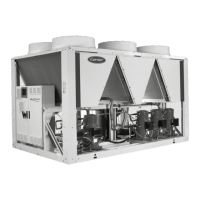IMPORTANT:
Never use a pressure water spray without a large diuser.
Concentrated and/or rotating water jets are strictly forbidden.
Never use a uid with a temperature above 45 °C to clean the
air-cooled exchangers.
Correct and frequent cleaning (approximately every three
months) will prevent two thirds of corrosion problems. Protect
the electrics box during cleaning operations.
13.7 - Water type heat exchanger
Check that:
- The insulation has not been detached or torn during
operations,
- The heaters and probes are operating and correctly
positioned in their supports,
- The water-side connections are clean and show no sign of
leakage,
- The periodic inspections required by local regulations have
been carried out
13.8 - Variable frequency drive
IMPORTANT: Before any work on the variable frequency
drive, ensure that the circuit is isolated and there is no voltage
present (reminder: The capacitors take approximately
5 minutes to discharge once the circuit breaker has been
opened). Only appropriately qualified personnel are
authorised to work on the variable frequency drive.
In case of any alarm or persistent problem related to the variable
frequency drive, contact the manufacturer's service department.
The variable frequency drives tted on the units do not require a
dielectric test, even if being replaced: they are systematically
checked before delivery. Moreover, the ltering components
installed in the variable frequency drive can falsify the measurement
and may even be damaged. If there is a need to test the insulation
of a component (fan motors and pumps, cables, etc.), the variable
frequency drive must be disconnected from the power circuit.
13.9 - Refrigerant volume
It is essential to run the unit in cooling mode to nd out whether
the charge is correct; this is done by checking the actual
subcooling.
Following a slight leak, it will be possible to detect a drop in the
refrigerant charge from the initial charge, and this will aect the
subcooling value obtained at the air-cooled exchanger outlet;
it cannot, however, be detected in heating mode.
IMPORTANT:
it is therefore not possible to optimise the charge in heating
mode following a leak. The unit must be run in cooling mode
if the charge needs topping up.
13.10 - Refrigerant properties
R32 properties
Saturated temperatures (°C) based on the relative pressure (in kPa)
Saturated temp.
Relative
pressure
Saturated temp.
Relative
pressure
Saturated temp.
Relative
pressure
Saturated temp.
Relative
pressure
-20 306 4 822 28 1730 52 3189
-19 321 5 851 29 1778 53 3264
-18 337 6 881 30 1828 54 3341
-17 354 7 912 31 1878 55 3420
-16 371 8 943 32 1929 56 3500
-15 388 9 974 33 1982 57 3581
-14 406 10 1007 34 2035 58 3664
-13 424 11 1040 35 2090 59 3748
-12 443 12 1074 36 2145 60 3833
-11 463 13 1109 37 2202 61 3920
-10 483 14 1144 38 2260 62 4009
-9 503 15 1181 39 2318 63 4099
-8 524 16 1218 40 2378 64 4191
-7 546 17 1256 41 2439 65 4284
-6 568 18 1295 42 2501 66 4379
-5 591 19 1334 43 2565 67 4476
-4 614 20 1375 44 2629 68 4575
-3 638 21 1416 45 2695 69 4675
-2 662 22 1458 46 2762 70 4777
-1 687 23 1501 47 2830
0 713 24 1545 48 2899
1 739 26 1635 49 2969
2 766 25 1590 50 3041
3 794 27 1682 51 3114
13 - STANDARD MAINTENANCE
85

